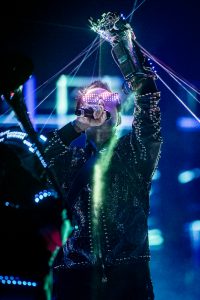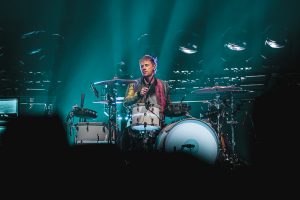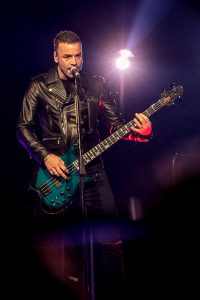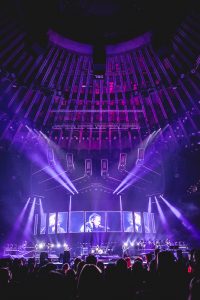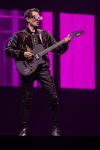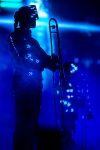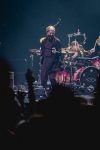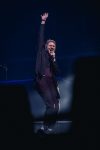REVIEW: Muse delivers sensory exhilaration at Oracle spectacle
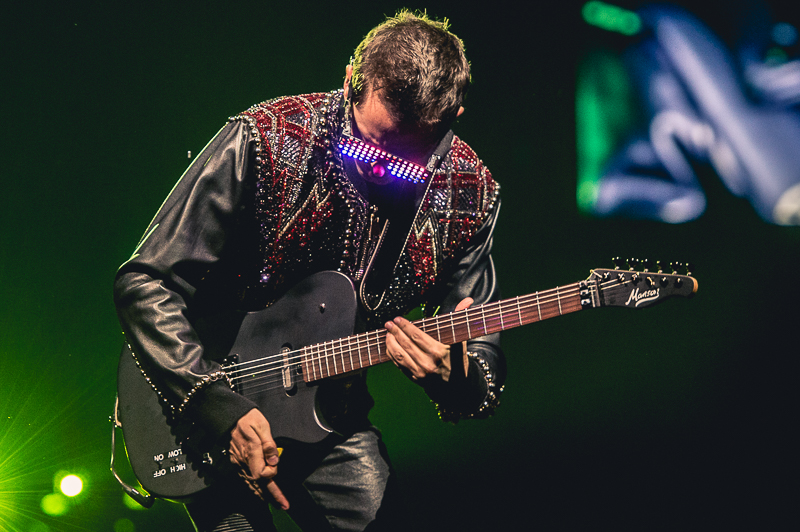
Muse performs at Oracle Arena in Oakland on March 9, 2019. Photos: Alessio Neri.
OAKLAND — It’s not exactly a trade secret that nearly 25 years into its career that Muse is one of the best live acts in modern rock. The band’s ‘all in’ attitude toward its live show has been evident going back to the beginning, when guitarist Matt Bellamy, drummer Dominic Howard and bassist Chris Wolstenholme used themselves as projection screens at early Bay Area shows. From the material to the production, stage design, Muse is reliably at its best live. The Resistance Tour (2009) saw the band performing on towering skyscrapers. The 2nd Law Tour (2012) pushed the boundaries on lighting and visuals. And 2015’s Drones Tour saw Muse performing in the round with the help of actual drones (when those worked). But even the savviest fans had to be Yale aback by the spectacle of Saturday’s Simulation Theory Tour show at Oracle Arena.
Following a string of musically heavy albums, Muse threw fans a curveball with 2018’s Simulation Theory. The album featured a more fun pop influence and stylistically incorporated ’80s musical callbacks and video game influences to its usual mix of Fahrenheit 451-esque doom and gloom. That mindset carried over to the band’s live performance, featuring a bright glowing stage with lights that criss-crossed the arena.
The opening scene alone was a sight to behold: a line of dark LED-bodysuit-wearing brass players encircled the stages ramp into the crowd as Howard pounded a drum dramatically. Bellamy rose up from the floor with his arm in the air, his Thanos-like metal glove reflecting the laser lights throughout the arena. The high drama mixed with the bombastic visuals and added supporting cast made the show feel like a futuristic video game come to life; a post-apocalyptic Cirque du Soleil. The band opened with an alternate version of “Algorithm” into the upbeat, brass-section infused dance rocker “Pressure.”
Bellamy had the floor jumping with “Psycho” before dropping in another new cut, “Break it to Me.” That song had a supporting cast of performers suspended in mid-air along the stages backline. Muse’s new material came alive in the live setting, allowing the core of the band’s sound to shine through.
Bellamy put down his guitar to lead the crowd in a singalong of resistance jam “Uprising.” He had a larger than life presence but executed it in such a downplayed manner that it never felt like a false persona. “Uprising” in particular has the infectious stadium quality that encourages the crowd to sing, stomp, and clap along in unison.
Bellamy strapped on a Fender Telecaster to deliver the blues stomp and bass groove of “Propaganda” before returning to the KAOS-pad-filled instrument to deliver the guitar intro of “Plug In Bay.” Bellamy’s guitar skills are formidable and his unorthodox soloing is sometimes reminiscent of Tom Morrello’s exploratory style. Muse played new cut “The Dark Side” before launching into one of its biggest singalong hits in “Supermassive Black Hole.” “Thought Contagion,” another stadium anthem, preceded an extended rhythm section jam by Howard and Wolstenholme. Muse kept the theatrics simpler for its most iconic songs, relying on the voices of the near-capacity crowd, such as with the classic “Hysteria.”
Going from one if its most intense instrumentals in “The 2nd Law: Unsustainable,” the band took center stage and stripped down for “Dig Down.” Bellamy sported his LED glasses on “Madness” and stared into the camera as the lyrics flashed on them. Oftentimes rock bands can be criticized for having too much production in the course of their live shows; that it can be used to mask bad songs, but with Muse this is not the case. The action on stage is over the top, but it didn’t feel forced.
Muse brought the show home with a string of some of its best-known songs: “Madness,””Mercy” and “Time is Running Out. Mercy crescendoed with the entire room being overwhelmed in confetti and explosion of reflective gold streamers. Bellamy returned to the stage afterward with a metal skull for the dramatic art-rock of “Take A Bow.” The band closed the main set with “Starlight,” the song that put Muse on the minds of mainstream music lovers.
The band reprised the album version of “Algorithm” to open up the encore, with Bellamy even sporting and LED- equipped jean jacket as dancers stalked the stage with glowing lightsaber-like swords. Next came a showstopper of a medley featuring some of the band’s heaviest rock songs including “Stockholm Syndrome,” “Assassin” and “Reapers,” all while a giant skeleton emerged from the back of the stage. It’s difficult to describe just how large the skull is, featuring a depth and definition that makes you feel as though it was going to get ahold of the band and come for the audience next. The show concluded in the band’s most traditional fashion, with Muse playing “Knights of Cydonia.”
Openers Walk The Moon performed a set of poppy, upbeat tunes like “Shut Up and Dance” and “Anna Sun.” Vocalist Nick Petricca’s excitement to be on such a big bill was clear from the start.
“We’re just like you,” Petricca said. “We’ve all loved Muse since we were little kids.”
- Muse performs at Oracle Arena in Oakland on March 9, 2019.
- Muse performs at Oracle Arena in Oakland on March 9, 2019.
- Muse performs at Oracle Arena in Oakland on March 9, 2019.
- Muse performs at Oracle Arena in Oakland on March 9, 2019.
- Muse performs at Oracle Arena in Oakland on March 9, 2019.
- Muse performs at Oracle Arena in Oakland on March 9, 2019.
- Muse performs at Oracle Arena in Oakland on March 9, 2019.
- Muse performs at Oracle Arena in Oakland on March 9, 2019.
- Muse performs at Oracle Arena in Oakland on March 9, 2019.
- Muse performs at Oracle Arena in Oakland on March 9, 2019.
- Muse performs at Oracle Arena in Oakland on March 9, 2019.
- Walk The Moon performs at Oracle Arena in Oakland on March 9, 2019.
- Walk The Moon performs at Oracle Arena in Oakland on March 9, 2019.
- Walk The Moon performs at Oracle Arena in Oakland on March 9, 2019.
- Walk The Moon performs at Oracle Arena in Oakland on March 9, 2019.
Follow writer Mike DeWald at Twitter.com/mike_dewald. Follow photographer Alessio Neri at Instagram.com/windowofcolor.

